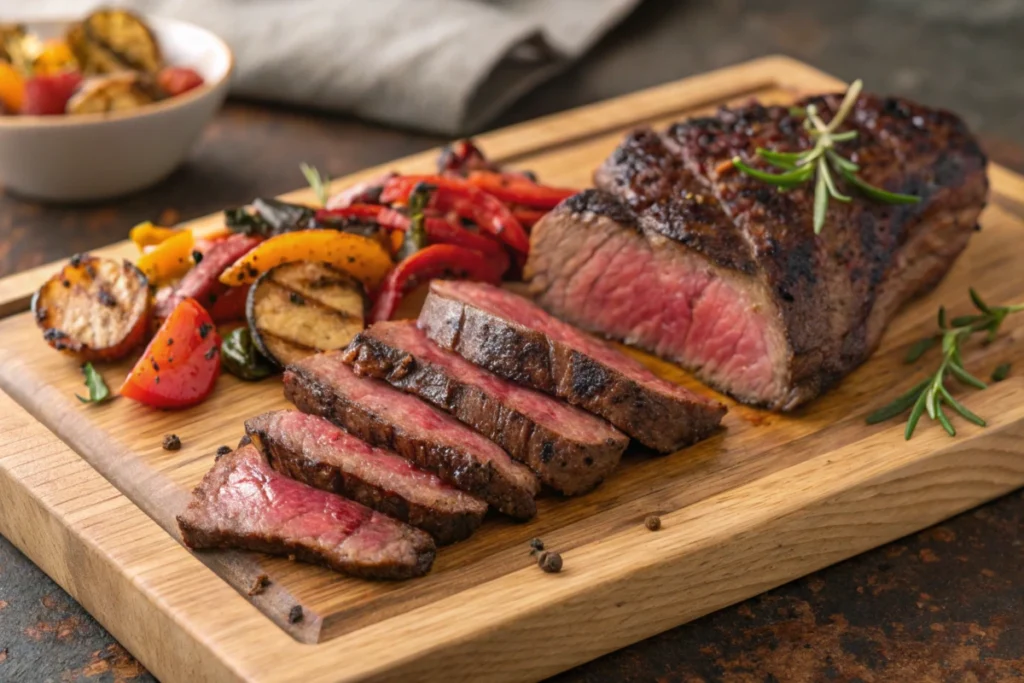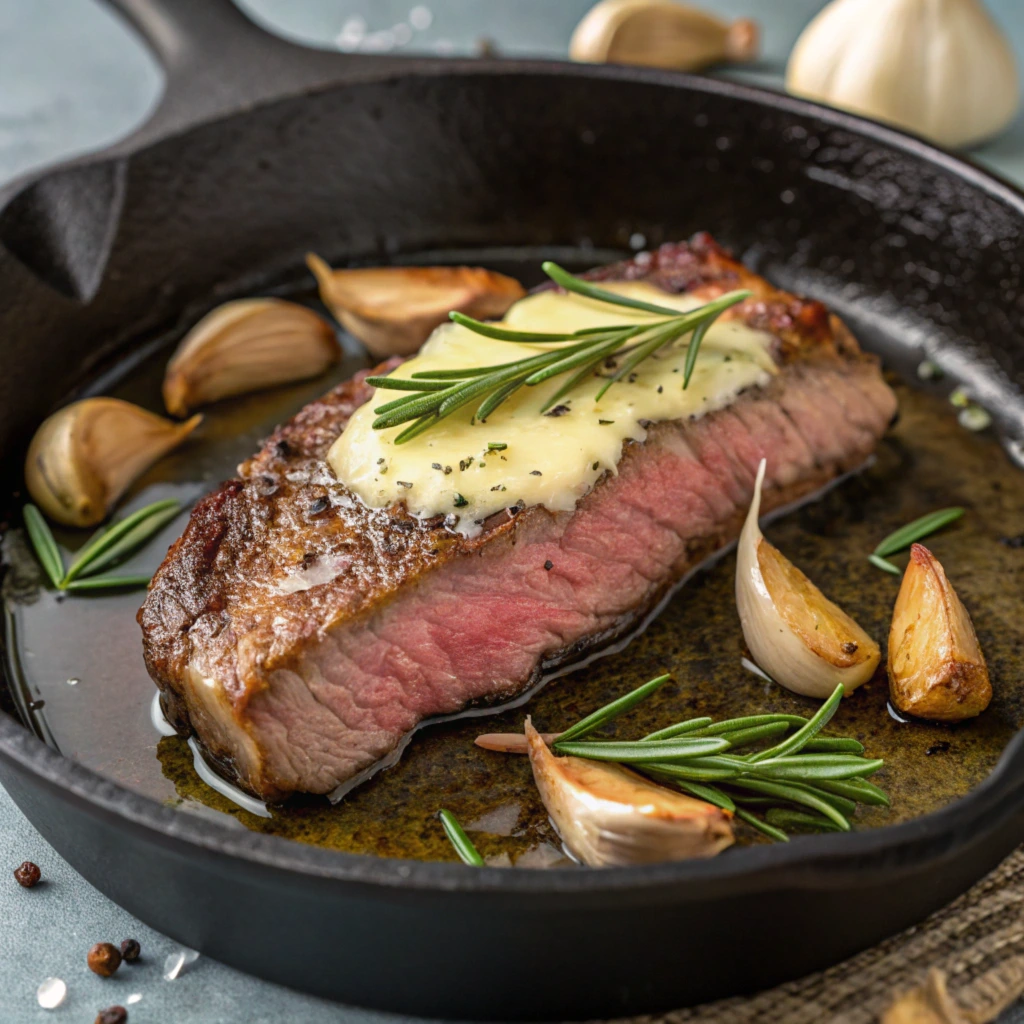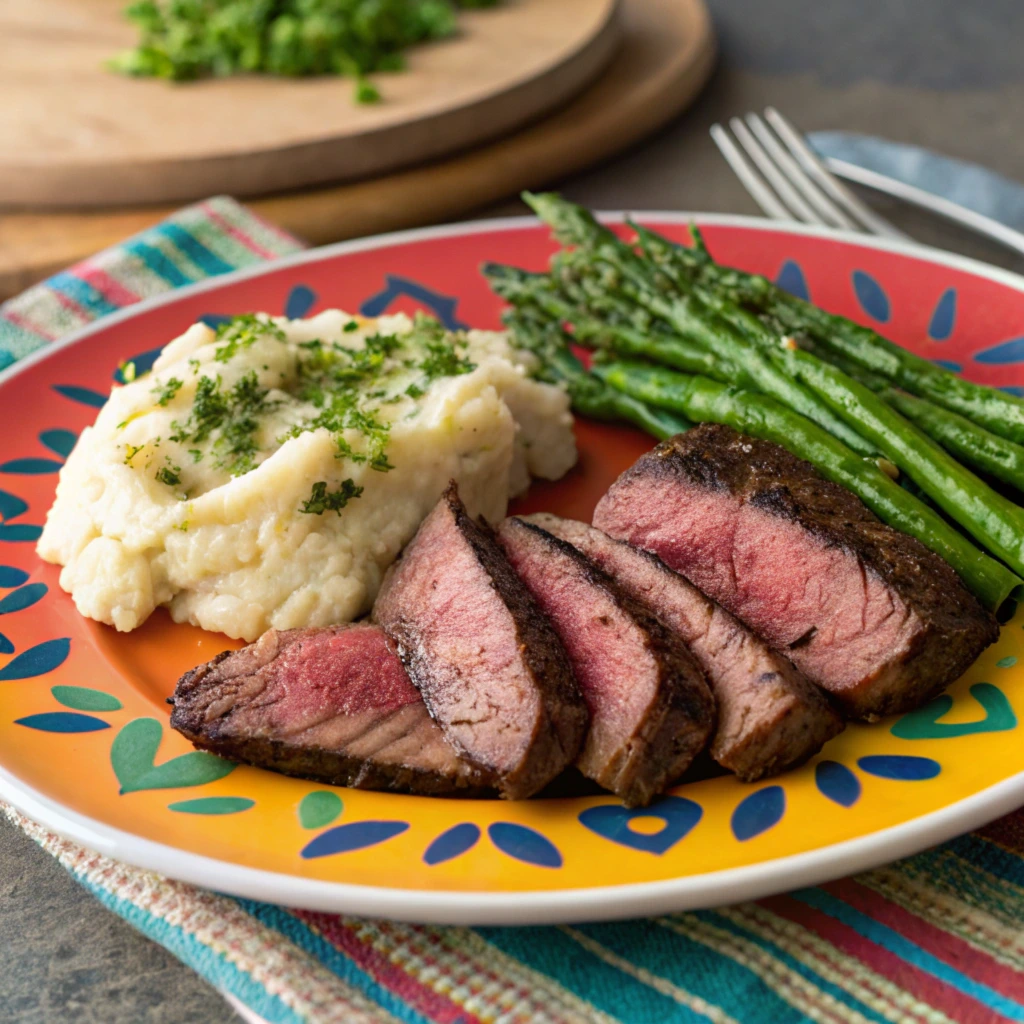
If you’re a steak lover, you’ve likely seen “beef loin flat iron steak” on menus or at the grocery store. This cut of beef is popular for its rich flavor, tenderness, and affordability. It’s a favorite among home cooks and professional chefs alike.
Understanding the label of a beef loin flat iron steak can help you make better buying choices. The label provides key details about the steak’s quality, origin, and nutritional value. These details can affect how the steak tastes and cooks.
In this article, we’ll explore all there is to know about beef loin flat iron steak labels. This guide will teach you how to decode the labels, select the best steak, and cook it with expert skill. Whether you’re new to cooking or a seasoned chef, this guide has something for you.
Table of Contents
What is Beef Loin Flat Iron Steak?
The beef loin flat iron steak offers exceptional tenderness and rich flavor, making it a prized choice among meat lovers. Butchers cut it from the shoulder region of the cow, also known as the chuck. In fact, many people consider it the second most tender cut after the filet mignon. This balance of tenderness and bold flavor makes it a popular option for those seeking both quality and value.
Interestingly, meat scientists developed this cut in the early 2000s using innovative butchering techniques. By removing tough connective tissues from the shoulder area, they unlocked a steak that combined tenderness with exceptional taste. Consequently, it quickly became a favorite among chefs and home cooks.
Origins and Popularity of Flat Iron Steak
Flat iron steak rose to fame because of its versatility and affordability. Initially, marketers promoted it as a budget-friendly alternative to expensive cuts like filet mignon. Over time, chefs and home cooks embraced it for its consistent quality and ease of preparation.
Furthermore, restaurants often include flat iron steak on their menus as a premium option for diners who enjoy bold, beefy flavors. At home, people love grilling, pan-searing, or slow-cooking this steak. Its natural marbling ensures a juicy, flavorful result, even with simple seasoning. As a result, it has become a go-to choice for quick weeknight meals and special occasions alike.
Understanding the Beef Loin Flat Iron Steak Label
The label on a beef loin flat iron steak holds valuable information that can guide your purchase and cooking experience. By learning how to decode the details on the packaging, you can make better choices and ensure the steak meets your expectations. Let’s explore the key elements found on the label and why they matter.
Key Elements on the Label
When you pick up a beef loin flat iron steak, the label provides critical details. It usually includes:
- Cut Name: Clearly states the specific cut, like “Flat Iron Steak.”
- Weight: Helps you determine portion size and cooking time.
- Price: Indicates cost per pound or kilogram.
- Grade: Shows quality, such as USDA Prime, Choice, or Select.
These elements give you an immediate sense of the steak’s value and suitability for your needs.
How to Decode Packaging Information
Packaging information isn’t just about aesthetics; it’s packed with insights. For instance:
- USDA Grading and Quality Indicators: USDA grades like Prime, Choice, or Select rank the meat’s marbling and tenderness. A prime steak has the highest marbling, ensuring a juicy and flavorful bite.
- Grass-Fed vs. Grain-Fed Beef: Labels often specify the cow’s diet. Grass-fed beef typically has a leaner texture and slightly earthy flavor, while grain-fed beef offers more marbling and a buttery taste.
- Expiry Dates and Storage Instructions: Look for the “use by” or “sell by” date to ensure freshness. Proper storage instructions, like refrigeration or freezing guidelines, help maintain quality.
USDA Grading and Why It Matters
The USDA grading system plays a significant role in selecting high-quality meat. Grades like Prime, Choice, and Select differ in marbling levels:
- Prime: Offers exceptional marbling, tenderness, and flavor.
- Choice: Balances quality and affordability with moderate marbling.
- Select: Provides leaner cuts at a budget-friendly price.
By understanding these grades, you can choose a steak that aligns with your preferences and budget.
Grass-Fed vs. Grain-Fed: What’s the Difference?
The cow’s diet directly impacts the flavor and texture of the meat. Grass-fed beef, raised on pastures, tends to be leaner and richer in nutrients like omega-3 fatty acids. On the other hand, grain-fed beef, finished on corn or grain diets, develops superior marbling for a tender, buttery taste.
Expiry Dates and Proper Storage
Pay attention to expiry dates to avoid purchasing old or spoiled meat. Labels also include storage tips, such as keeping the steak in the refrigerator or freezer to preserve freshness. For best results, store beef loin flat iron steak in an airtight container if you plan to freeze it.
Benefits of Choosing Beef Loin Flat Iron Steak
Beef loin flat iron steak isn’t just a popular cut; it also offers a range of benefits that make it stand out among other steak options. From its nutritional profile to its culinary versatility, this steak is an excellent choice for many households. Let’s explore why it’s worth adding to your menu.
Nutritional Profile of Flat Iron Steak
Flat iron steak provides a healthy balance of nutrients, making it a great addition to a balanced diet. A standard serving (about 4 ounces) typically contains:
- Protein: Around 23–25 grams, which supports muscle repair and growth.
- Iron: Essential for oxygen transport in the blood.
- Zinc: Boosts the immune system and aids cell repair.
- Vitamin B12: Supports nerve function and energy production.
Additionally, flat iron steak is relatively lean compared to cuts like ribeye, which makes it suitable for those monitoring fat intake. While it does contain some saturated fat, moderate consumption aligns well with most dietary goals.
Culinary Versatility of Flat Iron Steak
One of the top reasons to choose flat iron steak is its adaptability in the kitchen. Thanks to its even thickness and marbling, this cut cooks consistently whether you’re grilling, pan-searing, or using a sous vide method. Its bold, beefy flavor pairs beautifully with a variety of seasonings and marinades.
Some popular uses for flat iron steak include:
- Grilled Steak: Perfect for summer barbecues.
- Tacos and Fajitas: Slice it thinly and serve with fresh tortillas and toppings.
- Stir-Fry: Adds a rich protein base to quick, vegetable-heavy meals.
- Steak Sandwiches: Elevates a classic sandwich with its juicy texture.
Whether you’re aiming for casual dining or an elegant meal, flat iron steak delivers.
Sustainability and Ethical Considerations
Flat iron steak also appeals to environmentally and ethically conscious consumers. Many suppliers now offer grass-fed or sustainably raised beef loin flat iron steak options. These practices reduce the environmental impact and promote animal welfare.
When you choose flat iron steak labeled as grass-fed or organic, you’re supporting farmers who prioritize sustainable methods. While these options may cost slightly more, they often deliver superior flavor and nutritional benefits.
Why Flat Iron Steak Fits Special Diets
This steak fits seamlessly into various diets, including high-protein and low-carb plans like keto or paleo. It also satisfies nutrient needs for individuals with active lifestyles or those looking to reduce carbohydrate intake without compromising on flavor.
Cooking and Serving Beef Loin Flat Iron Steak

Cooking beef loin flat iron steak to perfection requires just a little know-how and preparation. Whether you’re grilling for a summer barbecue or pan-searing for a cozy dinner at home, this cut is incredibly versatile and forgiving. Let’s dive into how to prepare, cook, and serve this flavorful steak to impress your guests or elevate your weeknight meals.
Preparation Techniques for Flat Iron Steak
Preparing flat iron steak begins with proper trimming and seasoning. Although butchers often remove most connective tissue, double-check for any silver skin or extra fat that could impact the texture. Once trimmed, season your steak generously to enhance its natural flavors.
Marinating and Seasoning Tips
Flat iron steak absorbs marinades well, thanks to its open grain. Use marinades with acidic components like lemon juice, vinegar, or wine to tenderize and add depth to the flavor. Combine these with oils, herbs, and spices for the perfect balance. If you prefer a more straightforward approach, a dry rub with salt, pepper, and garlic powder works wonders.
For best results:
- Let the steak marinate for at least 30 minutes or up to 24 hours in the refrigerator.
- Remove it from the fridge 30 minutes before cooking to ensure even cooking.
Common Mistakes to Avoid
- Overcooking: Flat iron steak is best enjoyed medium-rare to medium. Overcooking can make it dry and less tender.
- Skipping Rest Time: Always let the steak rest for 5–10 minutes after cooking to allow the juices to redistribute.
- Using High Heat Alone: While searing is essential, combining searing with medium heat ensures the steak cooks evenly.
Best Cooking Methods for Flat Iron Steak
There are several ways to cook flat iron steak, depending on your equipment and preferences.
Grilling
Grilling brings out the natural smoky flavors of the steak. Preheat your grill to high heat and cook the steak for 3–4 minutes per side for medium-rare. For a perfect char, avoid flipping too frequently.
Pan-Searing
A hot cast-iron skillet is ideal for pan-searing flat iron steak. Heat a tablespoon of oil until it shimmers, then sear the steak for 3–4 minutes per side. Add butter, garlic, and rosemary during the last minute for added flavor.
Sous Vide
Sous vide cooking ensures precise temperature control. Seal the steak in a vacuum bag and cook it in a water bath at 130°F (54°C) for medium-rare. Finish with a quick sear in a hot pan for a caramelized crust.
Serving Suggestions and Pairings

Flat iron steak pairs well with a variety of sides and sauces. For a classic steak dinner, serve it with mashed potatoes, grilled vegetables, or a fresh salad. For a gourmet touch, drizzle chimichurri, béarnaise, or a red wine reduction over the sliced steak.
Creative serving ideas include:
- Tacos: Slice the steak thinly and serve with guacamole, salsa, and fresh tortillas.
- Steak Bowls: Combine with rice, beans, avocado, and veggies for a hearty bowl.
- Sandwiches: Layer with caramelized onions, arugula, and horseradish mayo on a crusty roll.
No matter how you serve it, flat iron steak brings bold flavors to the table.
Conclusion: Why Beef Loin Flat Iron Steak is a Must-Try Cut
Beef loin flat iron steak is a standout choice for anyone who loves flavorful, tender meat. Its unique combination of quality, affordability, and versatility makes it a must-try cut for both novice cooks and seasoned chefs. From the grocery store label to the dinner plate, this steak delivers an exceptional dining experience.
A Recap of Benefits and Highlights
To summarize, flat iron steak offers:
- Tenderness: Known as one of the most tender cuts after filet mignon.
- Rich Flavor: Its natural marbling provides a beefy taste that stands out.
- Culinary Flexibility: Adapts to various cooking methods, from grilling to pan-searing.
- Nutritional Value: Packed with protein, iron, zinc, and essential vitamins.
- Ease of Preparation: Simple to season, cook, and pair with sides.
The information on its label empowers you to select a steak that meets your taste and budget preferences. By understanding grading, diet distinctions, and storage guidelines, you can make informed decisions every time.
Final Thoughts and Recommendations
Whether you’re cooking for a family dinner or hosting a special gathering, flat iron steak offers the perfect balance of simplicity and sophistication. Its robust flavor, paired with its impressive tenderness, ensures satisfaction for any occasion. For the best results, take time to read the label, select a quality cut, and cook it to perfection.
If you haven’t already, give beef loin flat iron steak a try. At a reasonable cost, this cut provides the finest steakhouse dining experience in the convenience of your own home.
